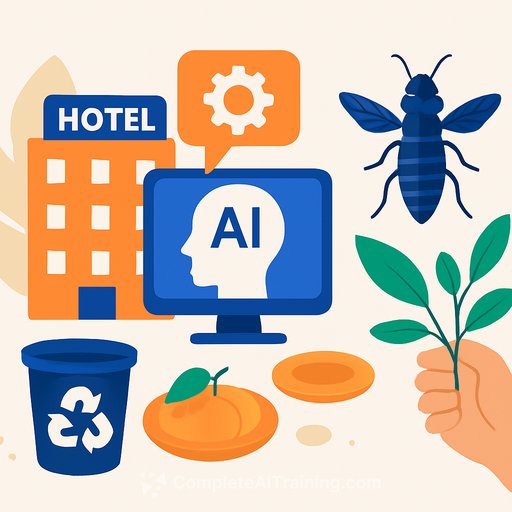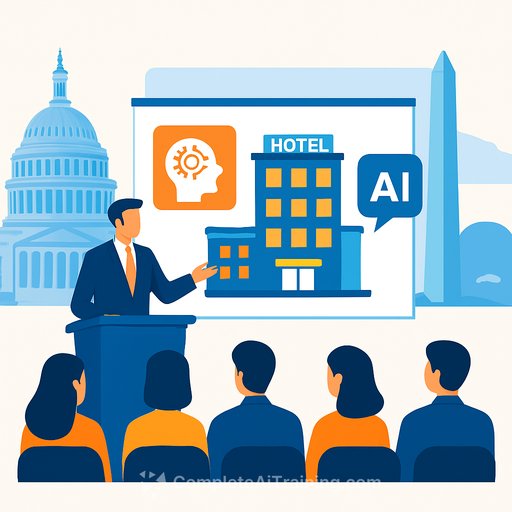Hotels, AI Scales, Smaller Plates: How Hotels Are Fighting Food Waste and Emissions
Big idea: Tech won't solve your climate targets on its own. But when you find a fix that works, roll it out fast across properties. Smarter kitchens today mean smaller footprints and tighter food costs tomorrow.
AI in the kitchen: what smart bins actually teach you
At Radisson's net zero hotel in Manchester, a smart bin weighs every scrap and converts it into CO2e. Their eSmiley system tracks plate waste, prep trim, and buffet leftovers. Chefs review the data, adjust production, and have already seen double-digit reductions.
That's the model: capture waste, analyze weekly, change menus and batch sizes, then repeat. Link your waste data to POS covers and event forecasts to set prep targets property-wide.
Do carbon labels change what guests order?
Yes-clear carbon labels nudge guests to lower-impact dishes without killing revenue. Pair the label with a short descriptor (Example: "Lower CO2e-local produce, less red meat") and set a default sustainable option for set menus and conferences.
Run A/B tests: one outlet with labels, one without. Track plate waste, gross margin, and guest satisfaction. Train servers with two-line talking points so the message stays helpful, not preachy.
Smaller plates, smarter buffets: do the nudges work?
Plate size and serving ware shape behavior. Smaller plates, shallow pans, and more frequent replenishment cut over-serving and keep food fresh-looking. Guests take less per trip and waste drops.
- Switch from 12-inch to 9-10-inch plates at breakfast.
- Use narrow trays and refill more often rather than loading full pans.
- Place proteins later in the line, greens and grains first.
- Add simple prompts: "Taste first-come back for more."
Where do black soldier fly larvae fit?
They're a circular end-point for unavoidable scraps. Certified partners use larvae to convert food waste into animal feed and soil inputs, cutting landfill and methane risk. It's not a replacement for prevention; it's a clean outlet after reduction and donation.
- Check local regulations and partner certifications.
- Separate post-consumer from pre-consumer if required.
- Keep contamination (plastics, bones, shells) out to maintain feed quality.
Playbook for GMs, F&B directors, and event leads
- Install digital waste tracking in back-of-house and buffets.
- Hold a 20-minute weekly chef review: top three waste items, root cause, one change per outlet.
- Menu-engineer with carbon labels and portion options (standard + light plate).
- Right-size buffets: smaller plates, smaller pans, batch cook, and late seating "cook-to-order."
- Create a donation pathway for safe surplus; route final scraps to BSF or anaerobic digestion.
- Ask event planners early: "Low-impact menu, plated service, or buffet? Any recovery plan for surplus?"
Metrics that matter
- Kg of food waste per cover (front and back of house).
- CO2e from waste (auto-calculated from tracked items).
- Waste cost per cover and reduction vs. baseline.
- Buffet leftover percentage by daypart and occupancy band.
- Donation rate and diversion rate (to BSF/anaerobic digestion).
Cost, savings, and quick wins
- Smart scales/bins and software: light capex; most see payback within months through reduced food purchasing.
- Plate and pan swap: low cost, immediate effect on waste and presentation.
- Menu tweaks and portioning: protect gross margin while improving guest choice.
Make it stick with people, not just tech
- Nominate a waste champion in each outlet; tie a small bonus to quarterly reduction targets.
- Post a simple scoreboard in the kitchen-yesterday's waste per cover and top waste item.
- Celebrate wins in pre-shift briefings; share photos of well-executed buffets and portioning.
Tooling and upskilling
If your team is new to AI-driven ops, start with short, practical training. A few hours of focused learning can help chefs, outlet managers, and revenue leads use data without friction. Explore job-focused courses here: Complete AI Training - Courses by Job.
Further reading
- UNEP Food Waste Index Report 2024 - global scale and policy signals.
- WRAP: Guardians of Grub - hospitality-tested tools and training.
Bottom line
Track everything, change one thing each week, and share what works across your portfolio. You'll cut emissions, reduce cost, and give guests a better dining experience-with less ending up in the bin.
Your membership also unlocks:






